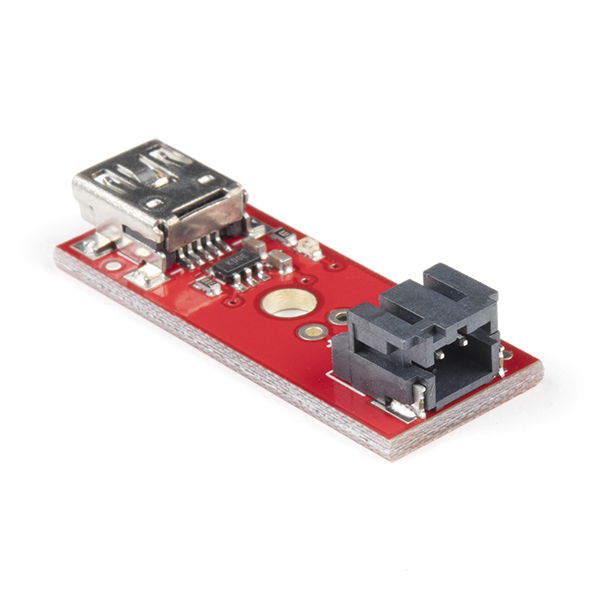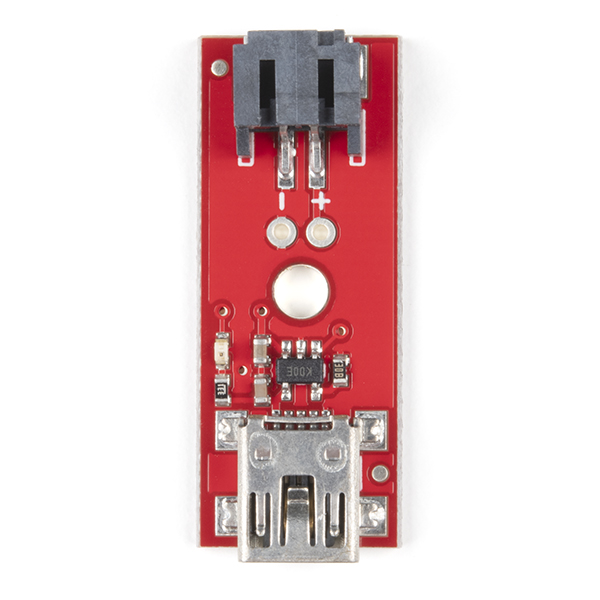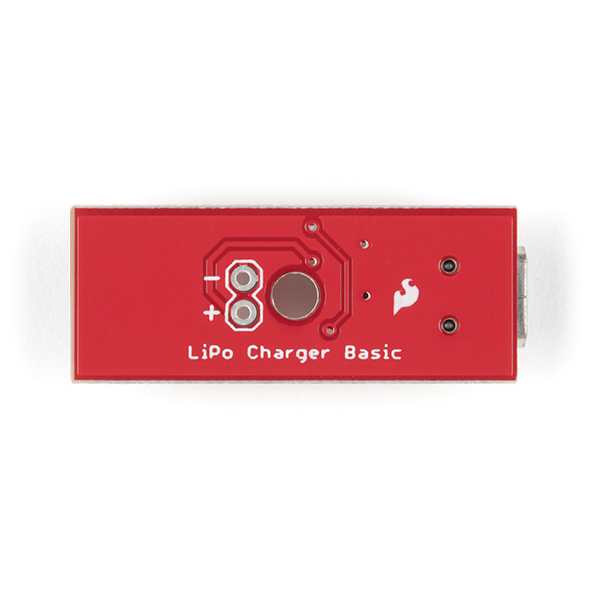SparkFun LiPo Charger Basic - Mini-USB
If you need to charge LiPo batteries, this simple charger will do just that. It is designed to charge single-cell Li-Ion or Li-Polymer batteries. Check the datasheet below to see if it will work with your battery.
The board incorporates a charging circuit, status LED, connector for your battery (JST-type used in the batteries we carry), and a mini-USB connector. However, we do not recommend this charger with a 110mAh battery.
Note: This version uses a mini-USB cable. We also have this charger with a micro-USB connection as well.
- 34.1x13.2mm
- Schematic
- Eagle Files
- Datasheet (MCP73831T)
- GitHub
SparkFun LiPo Charger Basic - Mini-USB Product Help and Resources
1 of 1 found this helpful:
Charge rate
The default charge rate for the LiPo Charger Basic is set to 500mA. The default output from a standard USB port is 500mA. In general, if you are charging your LiPo at a fast rate past the charge current specs of the battery, the life of the battery will go down. Looking at the charge rate for the battery, it looks like the recommended charge rate is 1C (or 400mA). I recommend changing the resistor that is on board to reduce charge rate. You can add some resistors in series between the PROG pin and resistor labeled 202 (this would require cutting a trace) or replacing the surface mount resistor with a higher resistance value. You can calculate the resistor value with the equation that is presented in section 5.1.2 Current Regulation Set (PROG) of the datasheet http://dlnmh9ip6v2uc.cloudfront.net/datasheets/Components/General%20IC/33244_SPCN.pdf.
1 of 1 found this helpful:
MCP73831T STAT Pin and STAT LED
If you look at the datasheet for the LiPoly USB Charger's IC controller, the LED is connected to the charge status output (STAT). This is an output to indicate the charge status which is explained in section 5.2.1 in table 5-1:
Shutdown: Hi-Z (High-impdedence mode)
No battery present: Hi-Z
Preconditioning: L (Low)
Constant-Current Fast Charge: L
Constant Voltage: L
Charge Complete – Standby: H (High)
Since the cathode (-) of the LED is connected to the controller, setting the pin low turns the LED on; setting the pin high (or putting it in high-impedence mode) turns the LED off. From the datasheet, this unit features “AutomaticPower-Down." So when the battery is fully charged, the LED should turn off and the charge IC controller should turn off. This can fluctuate back and forth with charging depending on if there is some small discharge with the LiPo battery.
Core Skill: Electrical Prototyping
If it requires power, you need to know how much, what all the pins do, and how to hook it up. You may need to reference datasheets, schematics, and know the ins and outs of electronics.
Skill Level: Noob - You don't need to reference a datasheet, but you will need to know basic power requirements.
See all skill levels
Comments
Looking for answers to technical questions?
We welcome your comments and suggestions below. However, if you are looking for solutions to technical questions please see our Technical Assistance page.
Customer Reviews
3.7 out of 5
Based on 3 ratings:
2 of 2 found this helpful:
No load sharing, but it charges!
The device doesn't have load sharing, meaning that it's not designed to be used in an embedded system, i.e., charging the battery while also powering the battery-powered circuit. If your load circuit consumes too much current (not tested, but guessing on the order of a milliamp), the charge may never "finish". The data sheet shows a simple circuit modification to allow this. The device works as designed, just keep that in mind.
0 of 1 found this helpful:
Works like it should
small, expensive and works
Nice and compact charger
Nice, small charger. Out of 100 received, 15 had 1 or more unsoldered leads on the mini usb connector. I'm good at hand soldering, so I repaired them myself. Other than that, they are a good, simple charger.
Sorry to hear that! If it happens again please contact our technical assistance team and we will help you.






Is this sewable?
Anything is sewable if you try hard enough. The battery connector and the USB connector are specific and so not really sewable. The power terminals are not designed for conductive thread, but with a thin enough needle you might be able to sew to it. On the other hand with the pins being so close together I'd worry about shorting. You may be better off soldering a piece of wire to each pad, pulling it off to the side and coiling the end (unstripped) and sewing conductive thread to that.
What is the Vf required on the STAT Led? Thanks.
Connect a battery with reversed polarity and instantly acquire magic blue smoke!
Where is the Blue Smoke repair kit you guys used to sell?
It would be great if this were combined with the LiPo fuel gauge board. Battery state + charging in one board would be amazing!
There are four different version of MCP73831T: Voltage Regulation Options: 4,20V, 4,35V, 4,40V, 4,50V. So, what is the regulation voltage of the chip used here?
Can this be used to charge 2 3.7V lipo batteries e.g. PRT-00341
Hi, how can I check if my battery is fully charged? Is there an indicator or something on the lipo charger? And does overcharging the polymer lithium ion battery damage it in a long run?
How many mAh is 3.7 volts? I know this is a dumb question but any feedback would be greatly appreciated.
I'm not sure you are understanding what volts or mAh are. The question is like saying my wall outlet is 110V, how much power do I consume a year. The two are not really related. Think of AA and AAA batteries. They are both 1.5V, but the AA are bigger and have a higher capacity. mAh is a rating of capacity. So if your system needs 3.7V you can use any 3.7V battery, the mAh rating will just tell you how long it will last.
Does this item have access to the data lines of the usb?
No it only uses the power
I could really use one with data connections too, would you consider adding the data lines on a future manufacturing run? I've created a revision to the Eagle files available here that could use the 4 pin Polarized Connectors PRT-08231 (https://www.sparkfun.com/products/8231). Modified Eagle files located at http://www.thundapurr.com/files/LiPo-Charger-Basic-v11.zip for anyone interested in making it themselves.
Noob question: is there a way I can power two devices with this? Say a micro board (arduino, teensy) AND a bluetooth module.
I have a question, I can charge the lipo battery 300mAh or need some modification in the resistor
You'd have to check the specs of your battery. This board is set up to charge at 500mA, so your battery would have to accept that. In a datasheet, there should be recommended charge currents or charge rate. A charge rate of 1C would essentially translate to 300mA - the 500mA would give ~1.67C. My guess is that the battery won't like that, and you would have to change the charge current - or check out one of the other battery charging solutions :)
will these charge a 2 cell battery if it has a built-in balance circuit?
I would like to build this into a device that may be exposed to rain/snow, and this being the only exterior connector makes me wonder: Is there any danger in the micro connector being shorted when not charging, so long as everything else is protected?
Dumb question here: are Lithium-Ion batteries the same as lithium polymers? Will this circuit charge L-ions?
Its been asked several times before, noone commented yet. Can I combine 10401 (LiPo Charger Basic) and 10255 (LiPower - Boost Converter) directly? Like one box with two USB connectors and a Lipo inside, where I can connect either a computer to charge the Lipo, or a mobile to charge this. Or even connect the box to an unreliable 5v source (bicycle generator comes to mind) and have the Lipo as kind of a USV?
I basically would connect the Lipo to both the charger and the step-up-converter, all three of them in parallel.
Any thoughts greatly welcome!
Are these fine to use without batteries as well? I'm building an exhibition with a whole lot of Arduino Pro Mini's and was thinking to use them connected to the USB ports of the computers that are connected to each one? Seems to work when I tested it - but not sure how it would be after a few days of continuous running?
In a show I ran last year - I had these connected to a 1000 mAh Li Polly - usually I'd leave them to charge overnight then let the Arduino Pro Minis run on the battery - occasionally I'd have to leave them pluged into the computer - in effect - charging for upto 48 hours.
One of my li polly batteries looked very swollen and puffed up at the end of this show - not sure if it was because it got left on 'charge' too long - or what…
Any recommendations would be most welcome
Cheers
Is this board set at a 500ma charge rate already or does it have to be set, I have a 3.7v 2200 mah battery with a 20c discharge rate so I definetly want the 500ma and not the 100ma?
Is the status led an on/off or a tri color operation?
It's on/off; on when it's charging, off when charge is complete.
Will this or any other of the USB chargers charge a 7.4v lipo battery?
no, you will need this or similar.
I tested one of these last night with an old Nokia Battery (the exploding kind) and it seem to work nicely using an old Motorola USB charger....
I was surprised it got really hot (the board - not the battery) for a while, as charging continued, the temperature decreased. seems logical as the battery voltage increases, less current, blah blah blah....
it was never THAT hot, but it did raise and alarm....
anyone think or notice the same?
What's difference between this and http://www.sparkfun.com/products/10161 ?
Can this be made or adapted to charge multiple LI cells in series, for example to boost the 5vdc input to 12V instead of regulating down to 4.2?
OR do you have another product that will?
Thank you.
Can you hook up a LED somewhere on this to show when it is charging then LED shuts off showing when battery is charged?
The datasheet says:
- Four Voltage Regulation Options: 4,20V, 4,35V, 4,40V, 4,50V
- Programmable Charge Current: 15 mA to 500 mA
How can I regulate that and how can I select a charge current or charge voltage?
Check the datasheet and schematic. program resistor is set to 2k, wihch means 500ma.
After reading it, does this mean that it cannot be set to charge at lower than 500mA? (As 2k is listed as the lowest)
I think so. I'd have to re-read it though.
Ok, is it better to charge at a lower charge current?
It depends on your battery. Look for the charging "C" rate for your battery, this will tell you whether 500mA is appropriate or not.
Can you use this board to charge a battery while it is connected to another circuit? Like if you split the wire from the battery and connected it to this charger board and the board the battery was meant to power at the same time?
no need to! it has solder through joints directly behind the jst adapter on the board does that help any
You are looking for this:
http://www.sparkfun.com/products/10161
HTH
Thanks for the info.
Looks like the only difference in the two boards schematics is the jumper for charging current and the two different connectors for system and batt. The system and batt outputs are both hooked up to the VBAT line though, so both boards are setup the same with the same charging IC. And actually I just noticed that this boards schematic lists the plus/minus connectors behind the battery connect as "Connected to 3.7V System". So both boards should be able to do in circuit charging.
I am also curious about this ... anyone know?
Lipo 3.7V max. rate 100 mAh?
Can this be used to charge a Li-ion 3.7V 800mAh (Pentax D-Li88)battery?
You know, just my luck they come out with a mini version right after I bought the micro. Down with Micro!
It'd be good if this and the Micro USB version had an "end view" picture to show the USB socket in more detail. Some people might not know if they have a cable for the Micro USB socket, or the Mini USB one.
Edit: Also, anyone else seeing the face in picture 4? :)
It's a happy lil' LiPo charger!
YES! I am one of the anti-micro USB nuts, so this is good news!